Vegan Doenjang Jjigae - Craving an umami-packed, authentic Korean flavor? This vegetarian/vegan version of Korean soybean paste stew will be sure to satisfy your craving!
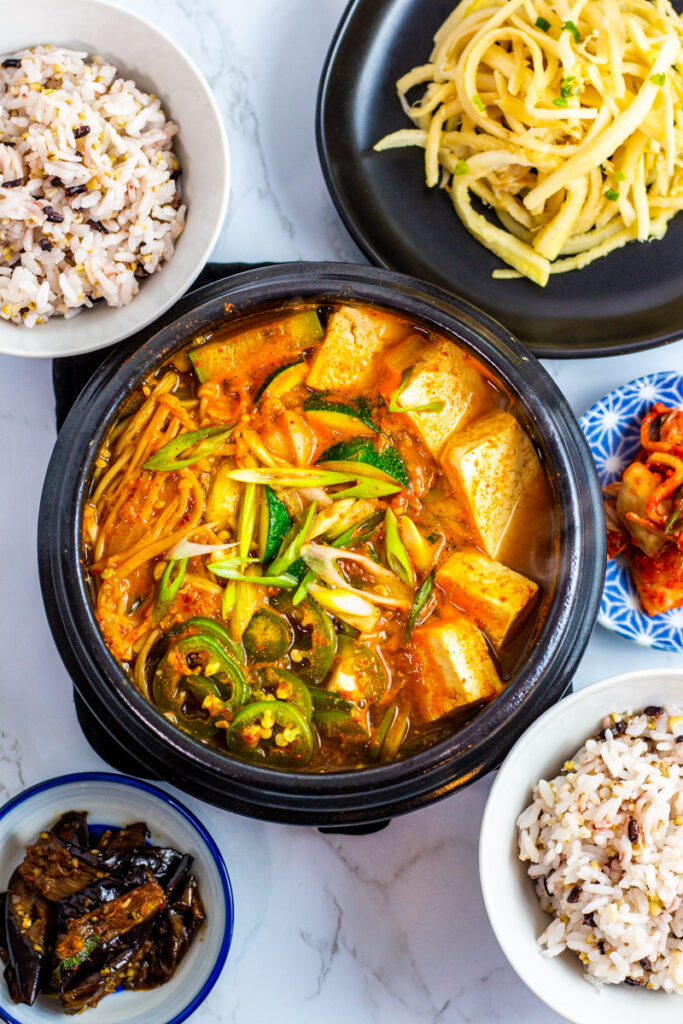
*The original post was published on July 10, 2019, and was updated on July 21, 2021*
When I first became a vegetarian, this dish is what I made to satisfy my Korean food craving. My maternal grandfather's daily diet consisted of doenjang jjigae (made without meat or seafood), kimchi, and rice. So I always knew doenjang jjigae (Korean soybean paste stew) could be made vegetarian/vegan.
What is Doenjang Jjigae 된장찌개?
Doenjang Jjigae (된장찌개 pronounced Doen-Jang-Jji(or chi)-gae) is a Korean stew made with Doenjang (Korean fermented soybean paste) and various vegetables and protein. It is one of the popular comfort food that many Koreans enjoy in their daily lives.
What is doenjang?
Doenjang 된장 is one of the traditional condiments in Korea. It is a fermented soybean paste made entirely of soybean and salt.
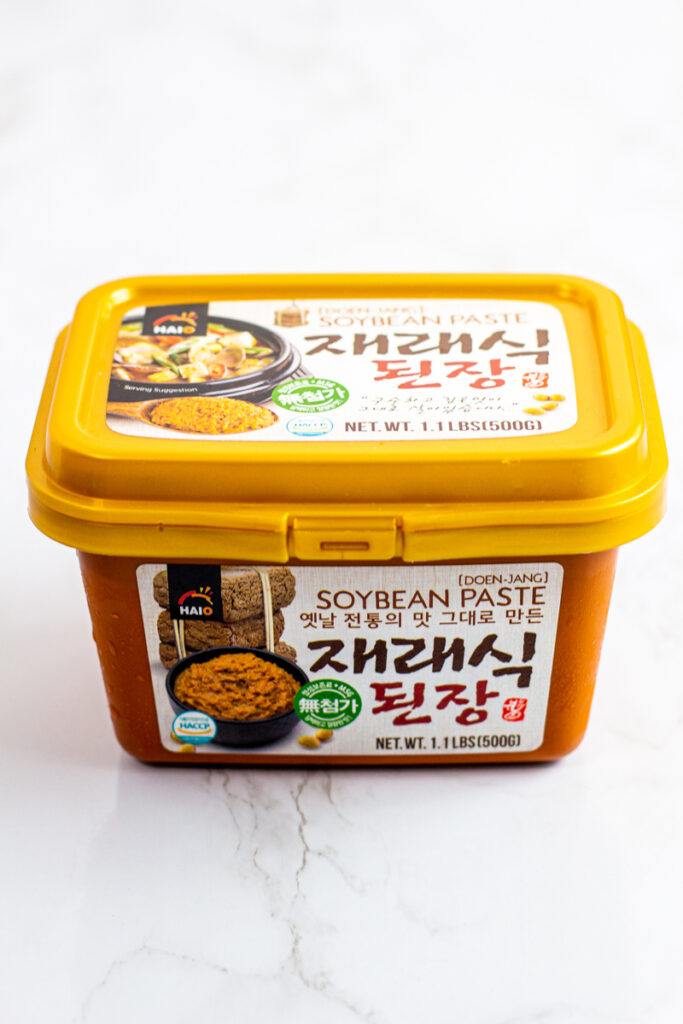
How long does Doenjang last?
Once opened, you should keep it in the refrigerator and it last about a year. The older doenjang tends to be drier and darker in color (due to oxidation) but it is perfectly safe to consume.
Where else can I use Doenjang?
Often, doenjang is used in many meat dishes in Korea. But if you are vegan, you can use doenjang in soup, vegetables, and sauce (such as Ssamjang) recipes.
What does doenjang jjigae taste like?
It is packed with a deep earthy and salty umami flavor with a hint of funk. You can think of it as a thicker and saltier version of miso soup with lots more vegetables. Although it is prepared with different types of vegetables and protein, it is a little salty. But the stew is meant to be eaten with a bowl of rice, not by itself.
Is Doenjang Jjigae Vegan?
Doenjang itself is vegan but it is often made with beef or seafood. The most popular ones are made with beef, dried anchovies, or clam. These ingredients are added to the stew at the beginning to create a deeper flavor in the broth. However, doenjang itself packs enough umami flavor of its own and it can easily be made vegan.
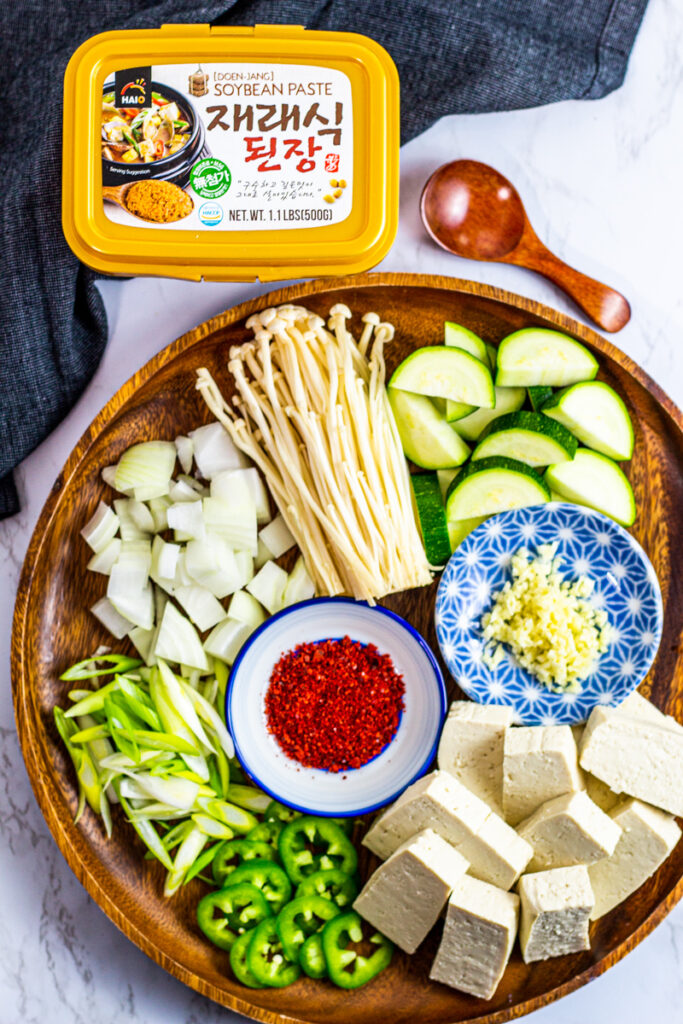
Ingredients
- Doenjang (Korean fermented soybean paste) - You can find this ingredient at any Korean grocery store. But make sure to pick up Doenjang, not Ssamjang (Korean dipping sauce) or Gochujang (Korean red pepper paste). If you don't live near Asian stores, you can always order them online.
- Water/Broth - To create a deeper flavor, you can add dried mushroom and/or dried kelp to make your dashi. However, this recipe is meant to be an easy dump-and-go so I'm using water.
- Vegetables
- Common vegetables - Minced garlic, green onion, onion, and zucchini are popular ingredients to add to the stew.
- Optional vegetables - Mushroom (I like to use enoki mushroom but button mushroom works great as well), hot pepper (such as jalapeno or serrano pepper), and daikon (Korean radish) are commonly found in the traditional stew.
- Protein - Tofu is almost always used in doenjang jjigae whether it's vegan or not. Tofu is the protein component of the soup and it is delicious (my favorite part of the soup). Use medium to firm tofu.
How to make doenjang jjigae without tofu
If you are not a tofu fan, you may omit it. Although it is not common to make the stew without it, you can still make it. Tofu contains lots of water and the vegetables also release water when cooking. To compensate for this, you need to increase the amount of water/broth and vegetables when making the stew.
You can add different types of protein such as beef, pork belly, or clam. But if you want to keep it vegan, you can add a small amount of potato. Potato takes longer to cook so make sure to cut them small and add them in the beginning. The potato will add an even more savory flavor and thickens the stew.
How to make Vegan Doenjang Jjigae
- Bring water to a boil in a pot and add Korean fermented soybean paste (Doenjang), minced garlic, and Korean red pepper flakes (gochugaru) if using.
- Add the tofu, mushroom, and onion to the stew. Bring it to a boil.
- Add the rest of the vegetables.
- Serve with rice.
Commonly asked questions
Doenjang being a fermented food, is full of micronutrients and has great health benefits. However, it contains a high level of sodium. If you need to watch your sodium intake, I recommend using less doenjang to make the stew. In addition, Korean stews are not meant to be eaten by themselves. The stew is meant to be enjoyed with a bowl of rice.
No. Doenjang is made with soybean and salt where miso has Koji (mold/fungus from grains) in addition. Miso is umami front and slightly sweet. But Doenjang is saltier, earthy, and has a deeper flavor. When the miso is cooked over time, it loses its flavor and fragrance where doenjang tends to develop a deeper flavor. If you want to learn more about doenjang, here is an excellent article you can read.
No. Ssamjang has doenjang as one of the ingredients but it is NOT the same. It is sweeter and somewhat tangier due to other ingredients. If you were to make a stew using ssamjang, it won't taste the same.
Traditionally, it is served with cooked rice and other side dishes (ban-chan 반찬) such as Kimchi and sauteed doraji. Also, it is a great addition to Korean BBQ such as bulgogi (here is my seitan bulgogi recipe).
Helpful Tips
- If you are not a fan of spicy food, omit gochugaru (Korean red pepper flakes) and jalapeno.
- If you are using daikon and/or potato, add them in the beginning right after adding doenjang. Boil them until they are almost cooked and follow the recipe as written.
- Using a clay pot is not required nor necessary. The clay pot tends to contain heat for a long time and keeps your stew hot longer.
- The stew will keep in the fridge for up to 4 days. You can freeze the stew but it will change the texture of the tofu once thawed.
- When reheating the stew, the tofu and vegetables might have absorbed some of the liquid in the stew. You can simply add a little more water when reheating the soup.
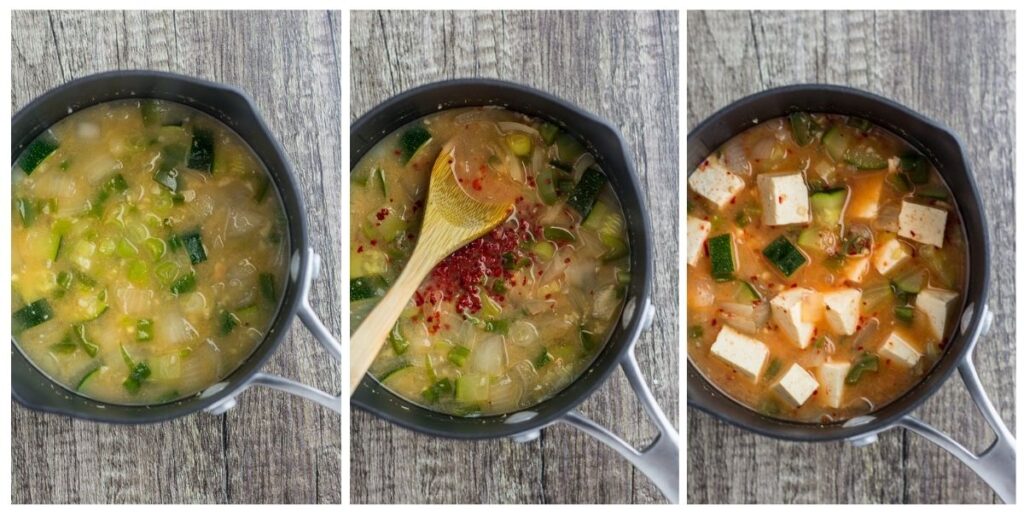
Vegan Doenjang Jjigae (Korean soybean paste stew)
Vegan Doenjang Jjigae - Craving an umami-packed, authentic Korean flavor? This vegetarian/vegan version of Korean soybean paste stew will be sure to satisfy your craving!
- Prep Time: 10 min
- Cook Time: 15 min
- Total Time: 25 minutes
- Yield: 2 servings 1x
- Category: Stew
- Method: Boil
- Cuisine: Korean
- Diet: Vegan
Ingredients
- 2 tablespoons Korean Soybean paste
- 1 and ½ cup water
- 2 teaspoons Korean red pepper flakes (optional)
- 3 cloves garlic, minced
- ½ block medium to firm tofu
- Mushroom (I use 1.5 ounces of enoki mushroom but you can substitute with 2 to 4 ounces of button mushroom)
- ½ large onion, chopped
- 1 jalapeño (or serrano pepper), sliced (optional)
- ½ zucchini, chopped
- 2 green onion, chopped
- Cooked rice (for serving)
Instructions
- In a small pot, bring 1 and a half cups of water to a boil. Add 2 tablespoons of Korean soybean paste, minced garlic, and Korean red pepper flakes (optional).
- Add chopped tofu, onion, and mushroom. Continue to boil for 5 minutes.
- Add the jalapeño (optional), zucchini, and green onion to the stew and boil for an additional 2 to 3 minutes.
- Serve with a bowl of rice.
Notes
- The original post was published on July 10, 2019, and was updated on July 21, 2021. The original post did not include mushrooms and the order of ingredients added to the stew has changed (the vegetables are added at last so that they won't be as soggy and the tofu is added earlier to soak up more flavor). However, both original and updated recipes capture the authentic flavor of the stew.
- If you are not a fan of spicy food, omit Gochugaru (Korean red pepper flakes) and jalapeno.
- If you wish to keep the stew vegan but don't want to use tofu, you can use a small amount of potato (please read the section "how to make it without tofu" above for detailed instruction).
- The stew can be stored in the fridge for up to 4 days. Although it can be frozen, it will change the texture of the vegetables and tofu.
- Please refer to the FAQ and helpful tip sections above for more information.


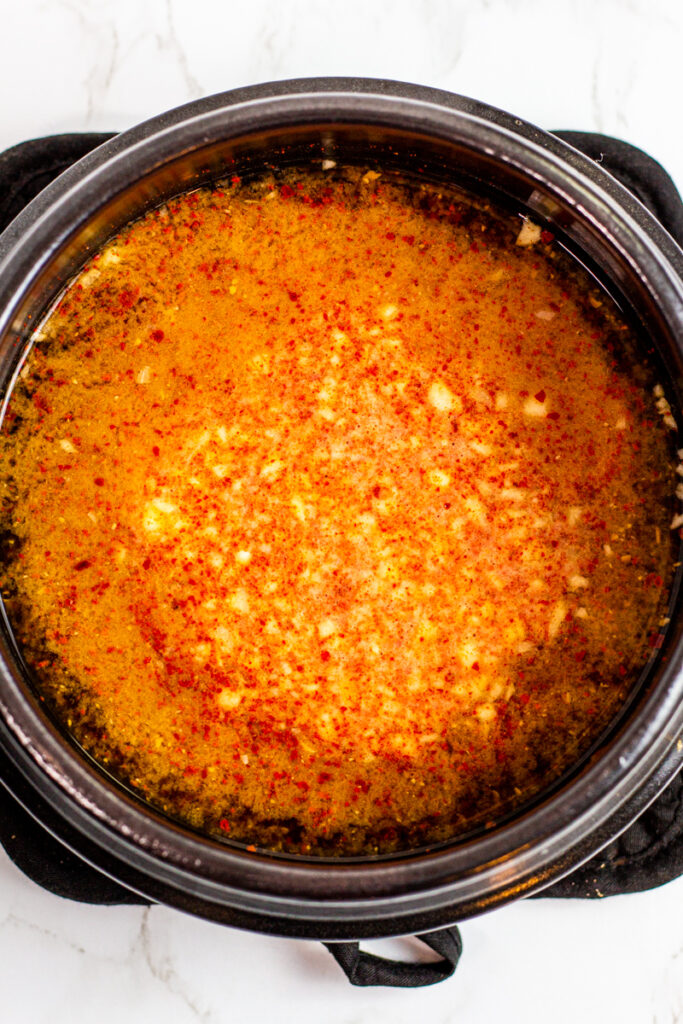
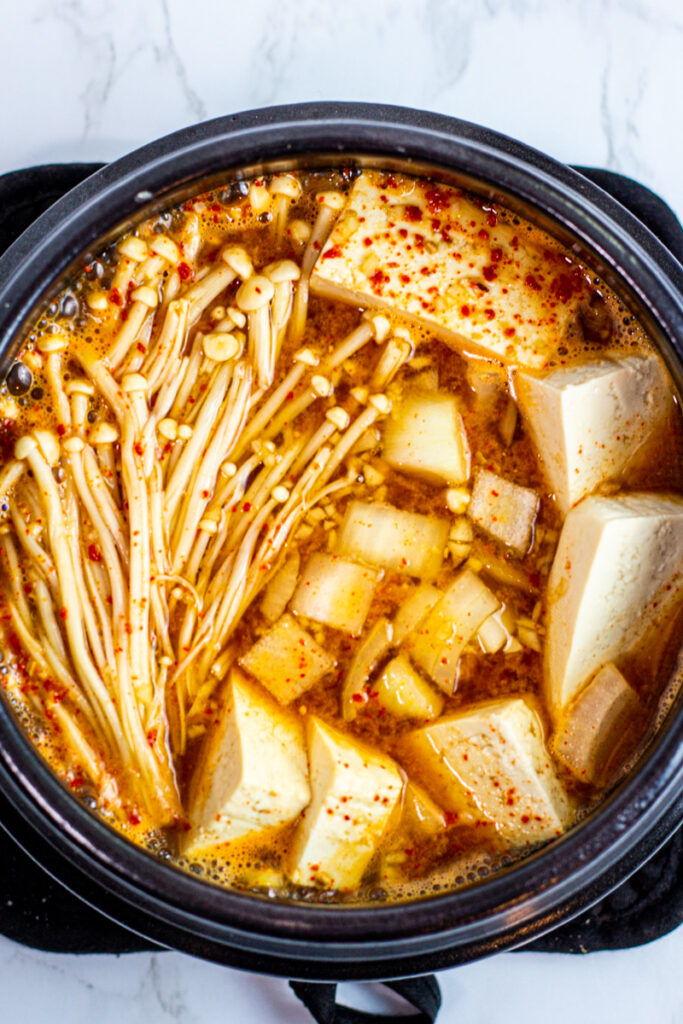
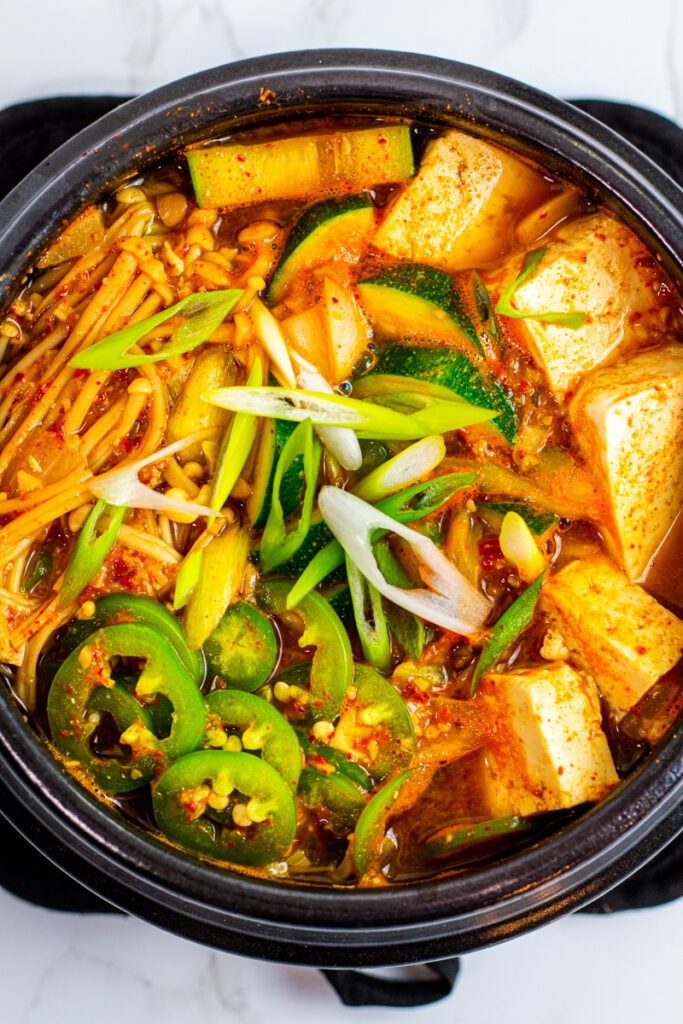
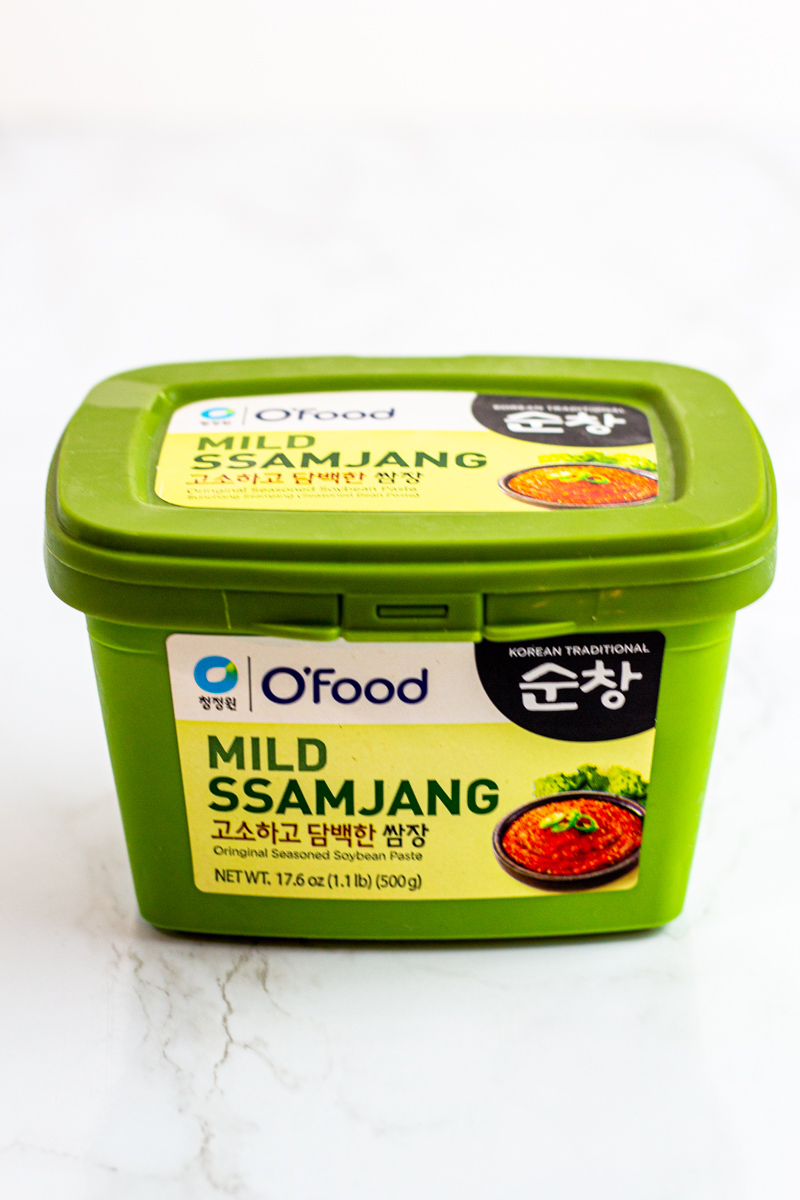
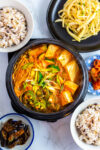
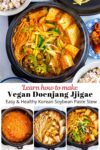
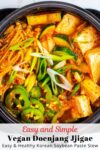
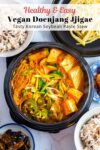
Tracy
I cannot wait for the temps to cool a bit here so I can make this!! It looks delicious.
George
Hahaha, yes! Let me know how you like the recipe when you give it a try, Tracy!
Jenny
I love Doenjang jigae! Thank you for your recipe. Please can you tell me which brands of Doenjang paste is considered vegan? Alot of them have some sort of seafood as flavour enhancers. Thank you.
George
Hi Jenny! The one that you can find on Amazon is "Wang Korean Doenjang, Fermented Soybean Paste, 1.1 Pound". But if you live near a Korean grocery store, you can try "100-day Soybean paste by Sempio". Hope this helps!
Vali
I’m cooking it right now and couldn’t help but notice that the measurements don’t add up when you use the tool. Like 2 1/2c of water isn’t the double of 1 1/2cup. Also it doesn’t increase in the text, which was quite confusing. i ended up using like 5 Cups of water and 3 pretty heaped tablespoons (I’m German, we just use an actual spoon for measurement, I hope this will add up to like 6 spoons as I should use) of the paste. Hope it turns out good.
George
Hi Vali! Thank you so much for bringing this to my attention. The recipe plugin that I use automatically scales my recipe so I wasn't aware of the water amount. If you'd like to double the recipe in the future, I'd use between 3 to 3 and 1/2cups of water. The vegetables and tofu contain water so even if the soup initially doesn't seem soupy enough, you will have enough broth at the end. Traditionally, Korean people season this soup with Doenjang but if you need to season more, you can use salt. Hope this helps and once again thank you so much for bringing this to my attention!
Faye
I made this today and it’s so yummy! My family enjoyed it. Thanks for sharing your recipe.
George
Hi Faye, I'm so happy to hear that you and your family enjoyed the recipe!